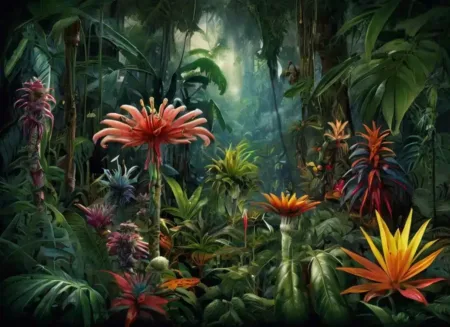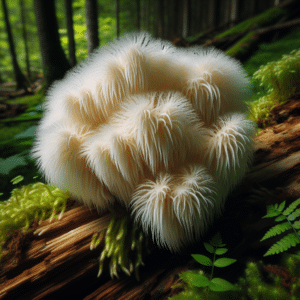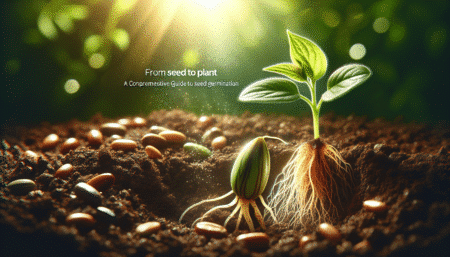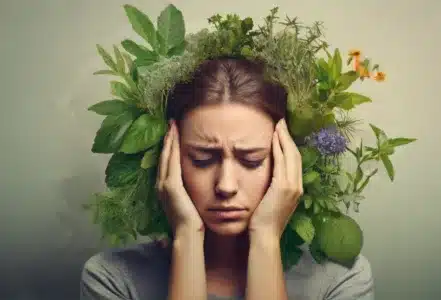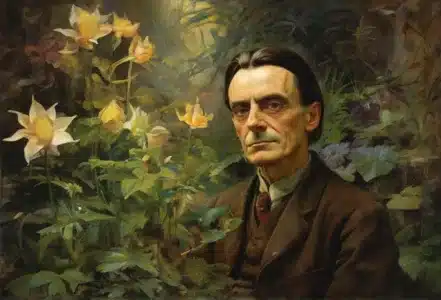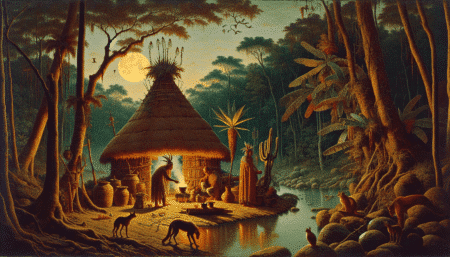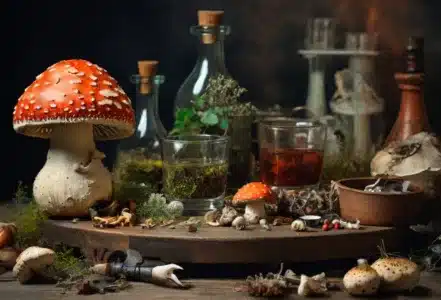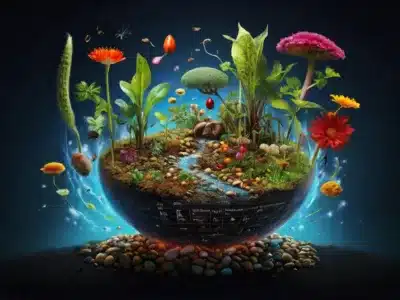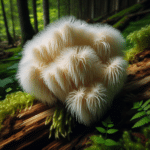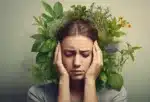- An excursion into the breathtaking flora of the Amazon
- The role of the Amazon in ethnobotanical research
- Ayahuasca: the spiritual brew
- Kambo: The purification ritual
- Yopo: The gateway to visionary worlds
- Chacruna and chaliponga: herbal ingredients of ayahuasca
- Conclusion
1. an excursion into the breathtaking flora of the Amazon
The Amazon region, known as the "lungs of the earth", is a melting pot of biodiversity, home to over 400 mammal species, 1,200 bird species, 3,000 fish species, 40,000 plant species and one million insect species [1]. As the world's largest tropical rainforest, covering nine countries in South America, the Amazon plays a crucial role in regulating the world's climate by absorbing carbon dioxide and producing oxygen [1][2]. Within this fascinating and vital region lies an immeasurable treasure: mind-altering plants whose effects and potential will lead you deep into the secrets of traditional and contemporary healing rituals.
These plants, including mandrake, yopo, angel's trumpet, cebíl and many more, form the basis of ancient knowledge and healing practices that have been used by indigenous peoples for centuries [3]. We immerse ourselves in the world of ayahuasca, a spiritual elixir, kambo, a purification ritual, and other psychoactive plants that open the door to visionary worlds. Their use is not only a testimony to the deep connection between man and nature, but also holds exciting prospects for modern medicine and therapy. This article, enriched with insights into ethnobotanical research and fascinating examples, invites you on a journey of discovery - ready to explore these extraordinary healing and spiritual plants of the Amazon?
2. the role of the Amazon in ethnobotanical research
Indigenous people have long used the rainforest as their pharmacy, with a variety of medicinal plants available [6]. Approximately one in four medicines contains an ingredient from the rainforest, and many more potential treatments remain undiscovered [6]. The Amazon rainforests are a significant source of medicinal plants, with over 40,000 plant species identified [7].
- Knowledge of the aboriginesIndigenous communities in the Amazon have extensive knowledge of medicinal and ritual plants, which is invaluable for ethnobotanical research [8]. A study of the Asháninka people in Peru identified 122 plant species used to treat various ailments [8].
- Threats and opportunitiesThe Amazon rainforest is threatened by deforestation, which jeopardizes potential medicinal plants and traditional knowledge [8]. The Amazon's ecosystem services, including ethnobotanical resources, have a global economic value of US$3.3 trillion per year [8]. Yet the Amazon rainforest receives less than 1% of global scientific research funding, hindering the progress of ethnobotanical studies [8].
Knowledge about medicinal plants is often passed on in an indigenous language, which emphasizes the importance of preserving these languages and cultures for medicinal and biological diversity [9]. In the Amazon region, 91% of medicinal plants have only one name and associated knowledge in an indigenous language [9].
3 Ayahuasca: the spiritual brew
Ayahuasca is a psychoactive brew made from two Amazonian plants, the Banisteriopsis caapi and the Psychotria viridis. It has been used for centuries by indigenous peoples for healing rituals and shamanic experiences [12].
- Ingredients and preparation:
- Banisteriopsis caapiAlso known as ayahuasca vine or yage. This plant contains MAO inhibitors that enable the body to absorb the active substances from Psychotria viridis.
- Psychotria viridisContains DMT (dimethyltryptamine), a strong psychoactive substance.
- PreparationThe ayahuasca broth is made by boiling the chopped ayahuasca vine and chacruna leaves together for several hours [17].
- Effects and therapeutic benefits:
- Change of consciousnessAyahuasca can alter the state of consciousness, allowing access to deeper levels of experience, higher states of consciousness and intense self-reflection [13].
- Therapeutic applicationThe potential of ayahuasca in the treatment of depression and addiction is particularly noteworthy [12]. It is also used in psychotherapy, including the treatment of alcohol dependence [16].
- Physiological and psychological effectsThe effects include a profound change in consciousness, increased emotional and self-reflective awareness and heightened sensory experiences. Physiological reactions include increased blood pressure and increased cortisol levels [15].
- Precautionary measures:
- Security and experienceDue to the increasing popularity of ayahuasca, unqualified individuals may misrepresent themselves as shamans, which can cause harm and damage the reputation of ayahuasca [13]. It is crucial to find a safe, trustworthy environment and an experienced team for an ayahuasca experience [13].
- Side effectsCommon side effects include nausea, vomiting and diarrhea [15].
Here you can find our Banisteriopsis caapi seeds and plants!
Here you can find our Psychotria viridis seeds and plants!
4. kambo: the purification ritual
The Kambo ritual is an ancient practice that originated among various indigenous peoples of the Amazon region [18]. It involves the application of secretions from the Phyllomedusa bicolor frog to the skin. These secretions contain powerful bioactive peptides that can strengthen the immune system and remove energy blockages [18]. The secretion is introduced into the body through small burns on the skin, which can trigger reactions such as nausea, tremors or heat sensations [18]. Preparation includes abstaining from alcohol and caffeine as well as mental preparation for the intense experience [18]. The Kambo ritual is not only a physical but also a spiritual journey that is often described as a transformative experience [18]. Participants are encouraged to take time for introspection and reflection after the ceremony [18].
- Extraction of the secretionThe secretion is obtained by gently stressing the frog, which causes it to release the secretion, which is then carefully collected [19].
- Positive effectsKambo can have positive effects both physically and mentally and can even be helpful in the treatment of depression [19]. The process, although painful, is often described as a beautiful spiritual experience [19].
Kambo can be used as an alternative treatment for various physical and mental conditions such as chronic pain, mental disorders and addictions [20]. However, the use of kambo as a treatment method is controversial among medical professionals [21]. The process of extracting the kambo secretion is considered morally questionable and can cause harm to the frogs [21]. In Germany, kambo is not illegal as a substance, but its use as a therapeutic or ritual practice is not legally regulated [21].
Kambo can be dangerous, especially when used improperly or by people with certain health conditions [21]. Potential risks include high blood pressure, dehydration, allergic reactions, infections and interactions with other medications [21]. Most people eliminate Kambo from their bodies within 24 to 48 hours after the ceremony [21]. Experiences after kambo vary from person to person and include intense physical sensations as well as feelings of clarity, renewal and emotional release [21].
5. yopo: The gateway to visionary worlds
Yopo, also known as Anadenanthera peregrina, is a tree native to South America and the Caribbean. Its seeds have been used in healing rituals by indigenous peoples for thousands of years. The seeds contain DMT, 5-MeO-DMT and bufotenin, which are potent hallucinogens [22].
- Traditional use:
- The seeds are ground into a powder [22].
- The powder is blown into the nose through a bamboo tube. This method is more effective and less irritating than sniffing the powder [22].
- Psychoactive compounds:
- DMT & 5-MeO-DMT: Among the most potent hallucinogens known and are responsible for the intense psychedelic experience associated with the use of Yopo [22].
- BufoteninA tryptamine compound, similar to serotonin, which has been studied for its psychedelic properties [22].
Yopo is rarely taken orally due to its unpleasant effects and the risk of negative side effects. The psychoactive compounds in Yopo can be enhanced by adding a monoamine oxidase inhibitor (MAOI) [22].
Here you can find our Anadenanthera peregrina or Yopo seeds!
6. chacruna and chaliponga: herbal ingredients of ayahuasca
Ayahuasca consists of the liana Banisteriopsis caapi and the leaves of Psychotria viridis (Chacruna) [4]. The liana contains MAO inhibitors that make the DMT from the leaves of Psychotria viridis effective when taken orally [4]. This combination allows DMT, a potent psychoactive molecule, to exert its full effect. DMT is not normally active orally because the enzyme MAO in our stomach breaks it down [17]. The MAO inhibitors in Banisteriopsis caapi liana prevent this breakdown, allowing DMT to develop its psychoactive effect [5].
- Main active ingredients in ayahuasca:
- DMT (dimethyltryptamine)A powerful hallucinogen that triggers intense visual and mental experiences [4][17].
- MAOIs (monoamine oxidase inhibitors)Contained in the Banisteriopsis caapi liana; enable the oral activity of DMT by preventing its degradation in the stomach [4][5].
- Other alkaloidsHarmine, harmaline and tetrahydroharmine contribute to the overall effect [4][11].
Chaliponga (Diplopterys cabrerana) is another plant that is sometimes used as a substitute for Chacruna [17]. It also contains DMT and MAO inhibitors, which makes it orally active on its own [17]. This variety of plants and their unique combination of active ingredients makes ayahuasca a particularly powerful brew. Ayahuasca is prepared by boiling the liana and leaves for several days, whereby the exact duration and ratio of ingredients can depend on the traditions of the respective indigenous groups [4].
The realization that DMT occurs naturally in various plants, animals and even in the human body opens up fascinating perspectives on the role of this substance in nature and its influence on human consciousness [5]. The combination of MAO inhibitors and DMT in ayahuasca allows for a unique experience that has both therapeutic potential and deep insights into the human psyche [4][5][17].
7. conclusion
This journey of discovery through the fascinating world of mind-altering plants of the Amazon highlights the immense importance of ethnobotanical research and the traditional knowledge of indigenous peoples. From ayahuasca to kambo, we have seen how these plants not only have profound spiritual and therapeutic effects, but can also be a potential tool for modern medicine. Their role in the treatment of depression, addiction and as a means of spiritual awakening opens up new horizons in the way we think about healing, health and consciousness itself.
However, it is crucial that we prioritize the protection of these plants and their natural habitat in the Amazon. The threat of deforestation and the loss of traditional knowledge require immediate action to preserve this irreplaceable treasure for future generations. By honoring and respecting indigenous knowledge, coupled with scientific research, we can ensure that the secrets of the Amazon's mind-altering plants continue to promote human well-being and connectedness with nature.
Further questions and answers on psychoactive plants
Which plant species can be found in the Amazon rainforest?
The Amazon rainforest is home to a variety of impressive plant species, including the kapok tree (Ceiba pentandra), the giant water lily (Victoria Amazonica), the rubber tree (Hevea brasiliensis), various orchid species (Orchidaceae), the passion flower (Passiflora), bromeliads (Bromeliaceae), the cocoa tree (Theobroma cacao) and the coffee plant (Coffea arabica).
What makes the Amazon rainforest so essential for the global climate?
The Amazon rainforest plays a key role in the global climate, as it stores twelve percent of the world's fresh water and is home to ten percent of all species worldwide. This biodiversity is not only important for the ecosystem, but also serves humans as a source of medicinal substances and as inspiration for technical innovations, such as in bionics.
To what extent is the Amazon considered a wonder of the world?
The Amazon region, as the largest river basin in the world, is home to more than half of all tropical rainforests and is therefore often referred to as the "green lung" of the earth. It makes an invaluable contribution to the Earth's climate and is home to a quarter of all known animal and plant species in the world, making it a true wonder of the world.
Which unique plants can be found in the tropical rainforest?
In the tropical rainforest, adventurers come across an abundance of special plants, including bromeliads, the elephant tree, the cocoa tree, mahogany, mangroves, a variety of orchid species and passion flowers.
Youtube
Note: The information in this article is for informational purposes only and is not intended to replace the advice of a physician or other healthcare professional. Always consult a doctor before using any new herbs or supplements. Furthermore, you should always check whether the cultivation/possession/use/processing of certain plants is permitted in your country. As we only offer ornamental plants in our store, we are only allowed to offer Provide information and advice on the correct care of plants!
Read more: Die faszinierende Welt der Bewusstseinsverändernden Pflanzen des AmazonasReferences
[1] – https://www.greenpeace.de/biodiversitaet/waelder/waelder-erde/amazonas-regenwald
[2] – https://www.planet-wissen.de/kultur/suedamerika/amazonien/index.html
[3] – https://www.lehmanns.de/shop/medizin-pharmazie/22735182-9783211992296-bewusstseinsveraendernde-pflanzen-von-a-z
[4] – https://www.chemie.de/lexikon/Ayahuasca.html
[5] – https://www.drinkguya.com/blogs/traditionelle-nutzung-von-guayusa/ayahuasca-zeremonie-retreat-wirkung-dmt-rezept
[6] – https://www.abenteuer-regenwald.de/wissen/pflanzen
[7] – https://www.wwf.de/themen-projekte/projektregionen/amazonien
[8] – https://abstracts.boku.ac.at/download.php?dataset_id=6767&property_id=107
[9] – https://www.scinexx.de/news/biowissen/indigenes-heilpflanzen-wissen-bedroht/
[10] – https://www.wwf.at/das-schuetzen-wir/wald/amazonas/
[11] – https://de.wikipedia.org/wiki/Ayahuasca
[12] – https://karger.com/szg/article/27/3/169/298746/Stellenwert-und-Funktion-von-Ayahuasca-Ein
[13] – https://acsauhaya.org/de/was-ist-ayahuasca/
[14] – https://www.gardenshaman.eu/en/2024/01/16/banisteriopsis-caapi-und-psychotria-viridis/
[15] – https://www.drugcom.de/drogenlexikon/buchstabe-a/ayahuasca/
[16] – https://www.spektrum.de/magazin/mit-ayahuasca-die-seele-heilen/1457423
[17] – https://www.amazonasschamanen.com/pflanzen/ayahuasca/herstellung/
[18] – https://lailas-little-luxury.de/der-ruf-des-amazonas-einblicke-in-die-kambo-zeremonie/
[19] – https://ayahuasca-retreat-colombia.com/de/kambo-zeremonie/
[20] – https://om-mij.nl/de/kambo/
[21] – https://www.sueddeutsche.de/stil/wellness-kotz-dich-gluecklich-1.4678343
[22] – https://www.sirius.nl/de/enzyklopadie/pflanzen/yopo/
[23] – https://www.wwf.de/themen-projekte/projektregionen/amazonien/der-amazonas-vor-dem-kollaps [24] – https://andeangreattreks.com/de/tourist-attractions/amazonas-regenwald-pflanzen/

